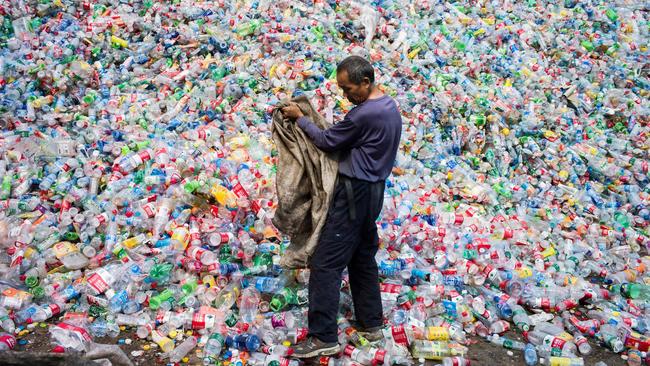China waste ban: What a load of rubbish
After China’s refuse refusal, Western countries are being buried in garbage; but it may offer Australia new opportunities.

When Australian environment ministers sat down to discuss what to do about the China ban on the nation’s domestic rubbish exports last week, plastics industry leaders in Europe were celebrating their first awards ceremony for the circular economy.
The new poster child for recycled plastics in Europe is, ironically, a vacuum cleaner. The Grundig model cleaner is reborn from the waste from electronic goods surrendered to the company factory. For industry, it is proof that recycled plastics can be substituted for virgin material to build quality products.
Another award winner was a plastic bottle that could be completely recycled, including the lid. What can seem a small thing is actually a big advance, a Holy Grail of plastics and a focus of intense international research.
The awards trophies were 3-D printed from 100 per cent recycled plastic from car instrument panels. A multi-colour top for the trophies was made from bottle caps recovered during beach clean-ups.
Churchill Fellowship scholar Helen Millicer attended the awards in The Netherlands from Melbourne, as part of a trip that takes in Germany, the European Commission, Britain and Thailand. Millicer, recycling strategy manager of the Vinyl Council of Australia, will meet the best minds in waste management to explore the cost-benefit equation of encouraging humans not to foul their own nest.
The journey already has taken her to a state-of-the-art incinerator in Amsterdam that imports trash from Britain to help meet its 100MW capacity.
“It works in The Netherlands because they don’t have landfill but the plant is heavily subsidised,” Millicer says. “I am not sure the economics of incinerators are going to stack up in Australia.”
But burning waste is one of the options on the table to combat the impact of China’s Green Sword policy, which has cut the pipeline for contaminated waste exports from around the world.
China’s waste ban, good news for its own environment, poses difficulties for countries that have come to depend on the trade.
“All the sorting centres are clogged. Our stocks are exceeding the allowed limits,” Pascal Genevieve, head of paper at Federec, the federation of French recyclers, told Politico.
Plastic, already a dominant global pollution issue, is quickly becoming more pressing.
According to one 2014 study China received 56 per cent by weight of global scrap plastic exports. China still wants scrap plastic but it wants it processed into pellets first.
Until now, China’s trade in rubbish had made sound economic sense. Cargo ships carry goods from China to Western countries and carry scrap back. China’s booming industries are near major ports and are hungry for plastics. Selling scrap to a broker to be shipped to China is cheaper than sending it to recycling facilities at home, University of California’s Kate O’Neill says.
In a global context, Australia is a relatively minor player. Federal Environment Minister Josh Frydenberg says Australia is one of more than 100 countries affected by China’s new restrictions.
The ban affects about 1.3 million tonnes, or 4 per cent, of Australia’s recyclable waste, but 35 per cent of recyclable plastics and 30 per cent of recyclable paper and cardboard.
The restrictions include new limits on contamination for recycled material that much of Australia’s recycling does not meet.
The Australian Council of Recycling says the China ban offers a once in a generation opportunity to “reset” Australia’s recycling systems.
The impact of the China ban domestically already has been profound. With China out of the market, the price paid for waste in Australia has dropped from about $350 a tonne to anywhere between $50 and zero. This has had a knock-on effect at local councils, which use fees from selling collected recyclable waste to underpin the kerbside recycling effort. At the other end, waste paper and plastic that used to go to export quickly is starting to clog waste facilities. Arguments are already being made to burn the waste for energy or to bury it in landfill.
It will be a critical decision because long-term investments will require long-term security of waste supply that could otherwise be recycled. Council of Australian Governments environment ministers support the move to a circular economy in which waste is recycled into new products but have left it up to industry to figure out how to do it.
Ministers agreed at COAG to a target that 100 per cent of Australian packaging be recyclable, compostable or reusable by 2025 or earlier. The 100 per cent target mirrors similar targets overseas, but critics say being recyclable is different from being recycled.
Environment groups are calling for compulsion. They say mandatory rules, as in Europe, are the only assured way to establish a stable and growing market to justify the investment into new manufacturing.
“If we can have an enforceable renewable energy target, then we can have a similar system for recycled content,” says Jeff Angel, director of the Boomerang Alliance of 47 national, state and local groups.
Greens spokesman senator Peter Whish-Wilson says the COAG targets are a diversion from the main game of dramatically reducing the amount of waste we produce and dealing with the mountains of already recyclable plastics that are building up because China won’t take our waste any more.
Australian Packaging Covenant Organisation chief executive Brooke Donnelly has no illusions about the scale of the challenge.
“The problem in Australia when you talk about recycling is always going to be the tyranny of distance,” Donnelly says.
“It is a large land mass with a relatively small population so sometimes what works really well in Europe is not going to work so well here.
“We have to work on what is the best way to collect and aggregate the material in the first place and then recycle it.”
One of the challenges is finding a product that covers the cost of collecting and aggregating the material and turning it into something else.
“It is one thing to develop a product that can be recycled. It is another to ensure it has a stable market in the long term,” Donnelly says.
Australia’s most successful recycling effort had been with paper and cardboard because manufactures have underwritten the collection price.
But expanding recycling capacity to deal with the exports lost to China will be expensive. Plastics are a high-profile challenge.
A growing list of companies are turning recycled plastics into furniture, garden edging, boardwalk replacements and other products.
And Donnelly says a breakthrough is close in expanding the usefulness of recycled plastic.
“A lot of these current applications have been about turning waste into other plastic products like garden furniture. There is a new technology in the final testing stages now that goes outside of that scope,” Donnelly says.
The goal is a closed loop within corporations, manufacturers, the agriculture sector and with consumers through better collection.
“The 100 per cent target is what we are trying achieve but there is a lot of complexity in that,” Donnelly says.
Container deposit schemes are seen as part of the recycling solution despite criticisms of the recently introduced NSW program. The NSW scheme has been faulted because only a small percentage of containers are being returned, leading to claims of profiteering. Angel says there have been problems with the NSW scheme but says it should be given time to settle in.
Donnelly says deposit schemes have been proven to be highly successful in other parts of the world.
“We need to be a little bit fair in letting these ones (NSW and South Australia) get up and going,” she says. “It is a new model in NSW because there was already kerbside collections in place, where South Australia is different because there was a history of deposit schemes before kerbside.”
Meanwhile, in an immediate response to the China ban, the NSW government announced a $47.25 million “support package” for local government and industry. This followed a $13m package announced by Victoria to support councils in offsetting gate fee increases.
The SA government has announced $300,000 in grants to fund the development of secondary reprocessing infrastructure.
But recyclables are being stockpiled nationally in the hope that China may change its mind. More appears to be headed for landfill and the fear is that household waste charges will increase and already low levels of recycling in some states will decrease further.
Australian Local Government Association president David O’Loughlin says critical issues go well beyond short-term funding relief. “What matters more is the creation of profitable uses and products for recycled materials, preferably onshore, if we are to lift the price points for plastics back to viable levels,” O’Loughlin says.
Angel says the drop in revenue for councils from the China ban has made kerbside recycling more risky. The solution, he says, is to produce uncontaminated waste through better kerbside separation and through container deposit schemes.
“There is no problem selling material that is uncontaminated. One of the tensions in the yellow bin kerbside collection scheme is that glass and paper are disposed of together.
“Going to a co-mingled yellow bin was a mistake. It is an economic proposition; the cleaner the material, the higher the price.”
Angel says the alliance supports recycled content standards where packaging must contain a set amount of recycled material.
“The issue with the packaging covenant is while it may demand waste stream to be 100 per cent recycling, reuse or to compost it, that is not to say it will be done,” he says.
Angel says there has been criticism of APCO in the past that it was an industry scheme to ward off regulation.
“They have now substantially changed their mission,” he says.
Angel’s main focus is on litter, including the impact of waste plastic and microbeads on marine systems.
Bans on single-use plastic bags will take effect in Queensland and Western Australia in July. Victoria is investigating details of a ban and NSW at present favours a voluntary scheme. Historic research by the Productivity Commission has found plastic bags to be a relatively minor issue because single-use bags often are put to other uses.
Research by the Institute of Public Affairs shows the heavier-grade plastic bags that will be sold to replace single-use must be used many times to result in a net environmental benefit. Discarded heavier-grade plastic bags pose a greater environmental threat than single-use ones.
Angel says only 2 per cent to 4 per cent of consumption of single-use bags end up in the litter stream but says there are 10 billion bags used each year in Australia.
He says most single-use plastic bags are sent to landfill, where they blow away and make up half the bags that end up as litter.
Angel says the recycling and litter issues represent the two sides of the same coin. Part of the solution to avoiding litter is better collection systems to stop waste getting to the point of litter, he says.
Recycling provides the financial support needed to create the collection infrastructure. There certainly will be a cost in recycling but Angel says he does not think consumer products will be made unattractive.
“It is inevitable the cost is passed on to consumers but industry and the makers of those products shouldn’t have to be pushed over years and years to make better environmental decisions,” Angel says.
Donnelly says consumers and government must share responsibility.
“If you put something out into the world, you do have a level of responsibility for it. That comes back to consumers: if you are consuming something, you have to accept that you have a level of responsibility for the waste that you create.
“It’s easy to have a conversation to pinpoint who is to blame here but it is not really about blame. It’s about let’s acknowledge we all have a role to play and a responsibility to act.”



